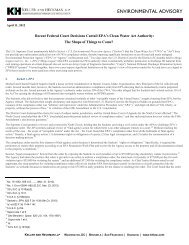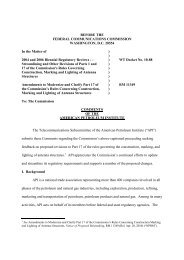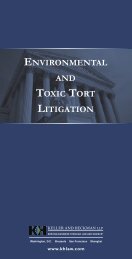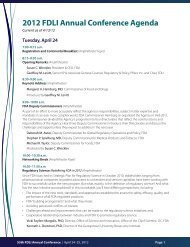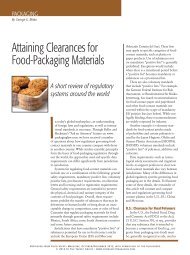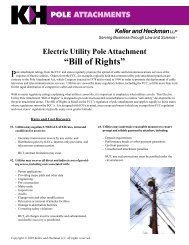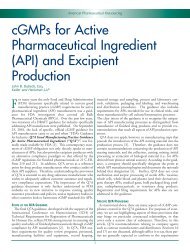A Practical Understanding of the Polymer ... - Keller Heckman
A Practical Understanding of the Polymer ... - Keller Heckman
A Practical Understanding of the Polymer ... - Keller Heckman
You also want an ePaper? Increase the reach of your titles
YUMPU automatically turns print PDFs into web optimized ePapers that Google loves.
The Two-Percent Rule<br />
14<br />
According to this provision, monomers and o<strong>the</strong>r reactants used or incorporated<br />
(whichever is less) at no more than two percent are only captured in polymer<br />
names at <strong>the</strong> option <strong>of</strong> <strong>the</strong> submitter. The level <strong>of</strong> use is relatively straightforward;<br />
<strong>the</strong> level <strong>of</strong> incorporation is relatively complex.<br />
In <strong>the</strong> context <strong>of</strong> <strong>the</strong> two-percent rule, <strong>the</strong> percent used means <strong>the</strong> weight percent<br />
calculated from <strong>the</strong> mass <strong>of</strong> <strong>the</strong> precursor charged divided by <strong>the</strong> mass <strong>of</strong> <strong>the</strong><br />
product formed (both on a 100-percent active basis). The calculation is independent<br />
<strong>of</strong> <strong>the</strong> degree <strong>of</strong> chemical incorporation <strong>of</strong> <strong>the</strong> polymer, so long as <strong>the</strong>re is some<br />
chemical incorporation.<br />
The percent incorporated in <strong>the</strong> amended two-percent rule means <strong>the</strong> weight<br />
percent calculated from <strong>the</strong> minimum mass <strong>of</strong> <strong>the</strong> precursor that <strong>the</strong>oretically could<br />
account for <strong>the</strong> mass or portion <strong>of</strong> <strong>the</strong> mass <strong>of</strong> <strong>the</strong> precursor that is chemically<br />
incorporated divided by <strong>the</strong> mass <strong>of</strong> <strong>the</strong> product formed (both on a 100-percent<br />
active basis). Where <strong>the</strong> percent incorporated is accessible and can be supported, it<br />
can lead to a lower percentage for decision making instead <strong>of</strong> <strong>the</strong> percent used.<br />
This can mean that polymers that used greater than two weight percent <strong>of</strong> a reactant<br />
and were denied eligibility solely on that basis could now be eligible if <strong>the</strong> degree<br />
<strong>of</strong> incorporation can be shown to be two weight percent or less. The percent incorporation<br />
is not <strong>the</strong> percentage <strong>of</strong> <strong>the</strong> mass <strong>of</strong> <strong>the</strong> reactant incorporated.<br />
Analytical data or appropriate <strong>the</strong>oretical calculations must be maintained at<br />
<strong>the</strong> site <strong>of</strong> manufacture or import to support <strong>the</strong> incorporation level. Theoretical<br />
calculations are permitted if it can be documented that analytical measurement is<br />
not feasible or necessary to support <strong>the</strong> determination <strong>of</strong> how much <strong>of</strong> a reactant is<br />
chemically incorporated.<br />
Simply stated, <strong>the</strong> two-percent rule means (a) that precursors <strong>of</strong> a polymer that<br />
are ei<strong>the</strong>r used or incorporated at no more than two weight percent, may be included<br />
in <strong>the</strong> description <strong>of</strong> a polymer manufactured from those precursors while (b)<br />
precursors used or incorporated (whichever is less) at more than two weight percent<br />
must be included in <strong>the</strong> chemical description reported and ordinarily will be<br />
reflected in <strong>the</strong> name <strong>of</strong> <strong>the</strong> polymer. 19/<br />
Please note that <strong>the</strong> two-percent rule does not mean that a precursor reflected<br />
in <strong>the</strong> description <strong>of</strong> a polymer must be used or incorporated at more than two<br />
weight percent. Conversely, a precursor reflected in <strong>the</strong> description <strong>of</strong> a polymer<br />
generally must not be omitted or reduced to only a probability <strong>of</strong> being chemically<br />
incorporated.<br />
We have confirmed that, under <strong>the</strong> EPA’s 1997 (current) polymer exemption<br />
guidance, <strong>the</strong> reporting provision known as <strong>the</strong> two-percent rule does not operate<br />
<strong>the</strong> same way as it does outside <strong>of</strong> <strong>the</strong> polymer exemption. Under <strong>the</strong> current polymer<br />
exemption, <strong>the</strong> EPA interprets <strong>the</strong> two-percent rule to mean that if a precursor<br />
is used or incorporated at less than or equal to two weight percent, 20/ <strong>the</strong> manufacturer<br />
or importer cannot include that precursor in <strong>the</strong> “identity” <strong>of</strong> <strong>the</strong> polymer. If a<br />
manufacturer or importer uses or incorporates a certain monomer or reactant in an




